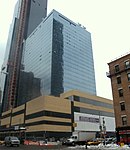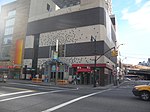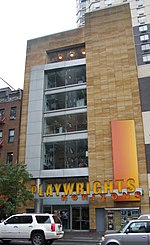West Side Airlines Terminal
1955 establishments in New York City42nd Street (Manhattan)Hell's Kitchen, ManhattanTransport infrastructure completed in 1955
The West Side Airlines Terminal was one of three air terminals in Midtown Manhattan. Located at the southeast corner of Tenth Avenue and West 42nd Street, the terminal operated from 1955 to 1972 and served as a location where passengers could purchase tickets and check baggage before boarding buses that would transport them Newark Airport. It was later repurposed to accommodate other uses before being demolished to make way for a 63-story mixed-use building, MiMA, that opened in 2011.
Excerpt from the Wikipedia article West Side Airlines Terminal (License: CC BY-SA 3.0, Authors).West Side Airlines Terminal
West 42nd Street, New York Manhattan
Geographical coordinates (GPS) Address Nearby Places Show on map
Geographical coordinates (GPS)
| Latitude | Longitude |
|---|---|
| N 40.759166666667 ° | E -73.995277777778 ° |
Address
One MiMA Tower
West 42nd Street 460
10036 New York, Manhattan
New York, United States
Open on Google Maps






